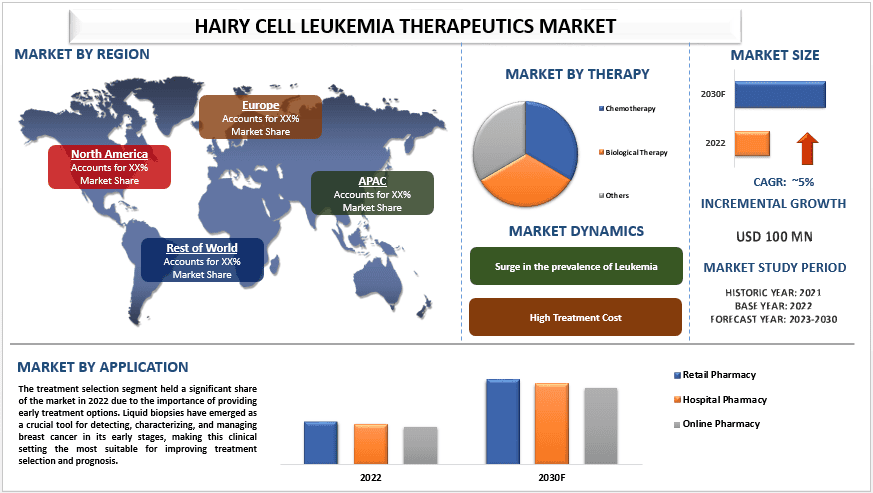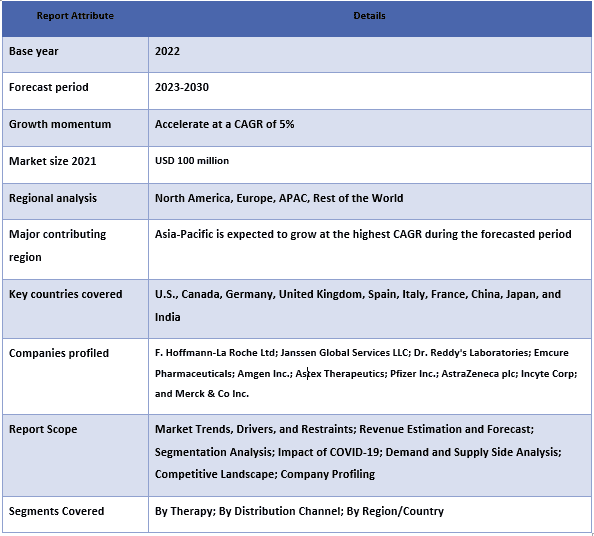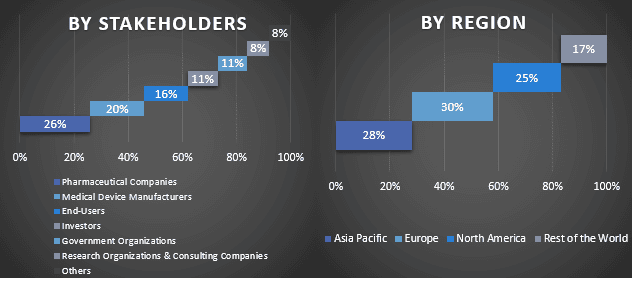- Home
- About Us
- Industry
- Services
- Reading
- Contact Us
Hairy Cell Leukemia Therapeutics Market : Current Analysis and Forecast (2023-2030)
Emphasis on Therapy (Chemotherapy, Biological Therapy, and Others); Distribution Channel (Online Pharmacy, Hospital Pharmacy, and Retail Pharmacy); and Region/Country.

The Hairy Cell Leukemia Therapeutics market was valued at USD 3265 Million and is expected to grow at a strong CAGR of around 5% during the forecast period (2023-2030). Several factors are expected to drive market growth, including the increasing number of leukemia cases, rising diagnosis rates, and the aging population. The elderly are particularly vulnerable to leukemia, which is anticipated to boost demand for effective treatment options. For example, according to the Mayo Clinic in 2022, hairy cell leukemia commonly affects individuals in their 50s or 60s and is more prevalent in men. Furthermore, the growth in funding for businesses and the focus on implementing various business strategies such as partnerships and clinical trials related to hairy cell leukemia are anticipated to drive the market. For instance, in November 2021, the Leukemia and Lymphoma Society and Hairy Cell Leukemia Foundation announced a five-year, USD 10 million partnership to support research on hairy cell leukemia (HCL), a rare hematological malignancy that affects the blood, spleen, bone marrow, and other organs. As part of this collaboration, the two organizations established the HCL 2025 grants program, aimed at improving patient outcomes by gaining a deeper understanding of HCL.
Some of the major players operating in F. Hoffmann-La Roche Ltd; Janssen Global Services LLC; Dr. Reddy’s Laboratories; Emcure Pharmaceuticals; Amgen Inc.; Astex Therapeutics; Pfizer Inc.; AstraZeneca plc; Incyte Corp; and Merck & Co Inc. Several M&As along with partnerships have been undertaken by these players to facilitate customers with hi-tech and innovative products/technologies.
Insights Presented in the Report
“Amongst therapy, the biological therapy segment to grow with high CAGR during the forecast period”
Based on the therapy, the market is segmented into chemotherapy, biological therapy, and others. The biological therapy segment is anticipated to grow with a significant CAGR during the forecast period. Targeted therapy has emerged as a promising approach in the treatment of HCL, offering more effective and less toxic treatment options compared to traditional chemotherapy. Firstly, it specifically targets cancer cells while sparing healthy cells, resulting in reduced toxicity and fewer side effects. Secondly, targeted therapies can often achieve higher response rates and longer-lasting remissions compared to chemotherapy alone. Lastly, targeted therapies can be used as maintenance therapy to prevent relapse and prolong survival.
“Amongst application, the treatment selection category held a significant share of the market in 2022”
By distribution channel, the market is categorized into retail pharmacy, hospital pharmacy, and online pharmacy. The hospital pharmacy held a significant share in the market in 2020. The rising prescription of medications at hospitals due to more frequent diagnoses at these institutions is a major factor driving the segment growth. Moreover, the increasing preference of patients to avail treatment in hospitals and the easy availability of medication in hospital pharmacies. Also, the tendency of consumers to visit hospital pharmacies for safe and authorized drugs is also driving the growth of this segment.
“Asia Pacific to grow with high CAGR during the forecast period”
The Asia Pacific region is expected to experience significant growth over the forecast period due to a combination of factors, including healthcare reforms, improving healthcare infrastructure, a growing population, and the entry of more companies into the market. With a large population and high cancer prevalence, as per Global Cancer Statistics 2020, an estimated 58.3% of cancer deaths occurred in Asia in 2020, making cancer screening a growing priority in the region. As a result, the use of screening tests for cancer has increased in recent years, with governments implementing initiatives such as free breast cancer screening and companies collaborating to increase the distribution and supply of these tests. For example, in 2021, Chinese startup AnchorDx collaborated with a top-tier hospital in China to develop a liquid biopsy test for early detection of breast cancer based on cfDNA.
Hairy Cell Leukemia Therapeutics Market Report Coverage

Reasons to buy this report:
- The study includes market sizing and forecasting analysis validated by authenticated key industry experts.
- The report presents a quick review of overall industry performance at one glance.
- The report covers an in-depth analysis of prominent industry peers with a primary focus on key business financials, product portfolios, expansion strategies, and recent developments.
- Detailed examination of drivers, restraints, key trends, and opportunities prevailing in the industry.
- The study comprehensively covers the market across different segments.
- Deep dive regional level analysis of the industry.
Customization Options:
The global hairy cell leukemia therapeutics market can further be customized as per the requirement or any other market segment. Besides this, UMI understands that you may have your own business needs, hence feel free to connect with us to get a report that completely suits your requirements.
Table of Content
Research Methodology for the Hairy Cell Leukemia Therapeutics Market Analysis (2023-2030)
Analyzing the historical market, estimating the current market, and forecasting the future market of the global hairy cell leukemia therapeutics market were the three major steps undertaken to create and analyze the adoption of hairy cell leukemia therapeutics in major regions globally. Exhaustive secondary research was conducted to collect the historical market numbers and estimate the current market size. Secondly, to validate these insights, numerous findings and assumptions were taken into consideration. Moreover, exhaustive primary interviews were also conducted, with industry experts across the value chain of the global hairy cell leukemia therapeutics market. Post assumption and validation of market numbers through primary interviews, we employed a top-down/bottom-up approach to forecasting the complete market size. Thereafter, market breakdown and data triangulation methods were adopted to estimate and analyze the market size of segments and sub-segments of the industry pertains to. Detailed methodology is explained below:
Analysis of Historical Market Size
Step 1: In-Depth Study of Secondary Sources:
Detail secondary study was conducted to obtain the historical market size of the hairy cell leukemia therapeutics market through company internal sources such as annual reports & financial statements, performance presentations, press releases, etc., and external sources including journals, news & articles, government publications, competitor publications, sector reports, third-party database, and other credible publications.
Step 2: Market Segmentation:
After obtaining the historical market size of the hairy cell leukemia therapeutics market, we conducted a detailed secondary analysis to gather historical market insights and share for different segments & sub-segments for major regions. Major segments are included in the report as therapy and distribution channel. Further country-level analyses were conducted to evaluate the overall adoption of testing models in that region.
Step 3: Factor Analysis:
After acquiring the historical market size of different segments and sub-segments, we conducted a detailed factor analysis to estimate the current market size of the hairy cell leukemia therapeutics market. Further, we conducted factor analysis using dependent and independent variables such as therapy and distribution channel of the hairy cell leukemia therapeutics market. A thorough analysis was conducted for demand and supply-side scenarios considering top partnerships, mergers and acquisitions, business expansion, and product launches in the hairy cell leukemia therapeutics market sector across the globe.
Current Market Size Estimate & Forecast
Current Market Sizing: Based on actionable insights from the above 3 steps, we arrived at the current market size, key players in the global hairy cell leukemia therapeutics market, and market shares of the segments. All the required percentage shares split, and market breakdowns were determined using the above-mentioned secondary approach and were verified through primary interviews.
Estimation & Forecasting: For market estimation and forecast, weights were assigned to different factors including drivers & trends, restraints, and opportunities available for the stakeholders. After analyzing these factors, relevant forecasting techniques i.e., the top-down/bottom-up approach were applied to arrive at the market forecast for 2030 for different segments and sub-segments across the major markets globally. The research methodology adopted to estimate the market size encompasses:
- The industry’s market size, in terms of revenue (USD) and the adoption rate of the hairy cell leukemia therapeutics market across the major markets domestically
- All percentage shares, splits, and breakdowns of market segments and sub-segments
- Key players in the global hairy cell leukemia therapeutics market in terms of products offered. Also, the growth strategies adopted by these players to compete in the fast-growing market
Market Size and Share Validation
Primary Research: In-depth interviews were conducted with the Key Opinion Leaders (KOLs) including Top Level Executives (CXO/VPs, Sales Head, Marketing Head, Operational Head, Regional Head, Country Head, etc.) across major regions. Primary research findings were then summarized, and statistical analysis was performed to prove the stated hypothesis. Inputs from primary research were consolidated with secondary findings, hence turning information into actionable insights.
Split of Primary Participants in Different Regions

Market Engineering
The data triangulation technique was employed to complete the overall market estimation and to arrive at precise statistical numbers for each segment and sub-segment of the global hairy cell leukemia therapeutics market. data was split into several segments & sub-segments post studying various parameters and trends in the areas of therapy and distribution channel in the global hairy cell leukemia therapeutics market.
The main objective of the Global Hairy Cell Leukemia Therapeutics Market Study
The current & future market trends of the global Hairy Cell Leukemia Therapeutics market were pinpointed in the study. Investors can gain strategic insights to base their discretion for investments on the qualitative and quantitative analysis performed in the study. Current and future market trends determined the overall attractiveness of the market at a regional level, providing a platform for the industrial participant to exploit the untapped market to benefit from a first-mover advantage. Other quantitative goals of the studies include:
- Analyze the current and forecast market size of the hairy cell leukemia therapeutics market in terms of value (USD). Also, analyze the current and forecast market size of different segments and sub-segments
- Segments in the study include areas of therapy and distribution channel
- Define and analysis of the regulatory framework for the hairy cell leukemia therapeutics industry
- Analyze the value chain involved with the presence of various intermediaries, along with analyzing customer and competitor behaviors of the industry
- Analyze the current and forecast market size of the hairy cell leukemia therapeutics market for the major region
- Major countries of regions studied in the report include Asia Pacific, Europe, North America, and the Rest of the World
- Company profiles of the hairy cell leukemia therapeutics market and the growth strategies adopted by the market players to sustain in the fast-growing market
- Deep dive regional level analysis of the industry
Related Reports
Customers who bought this item also bought










